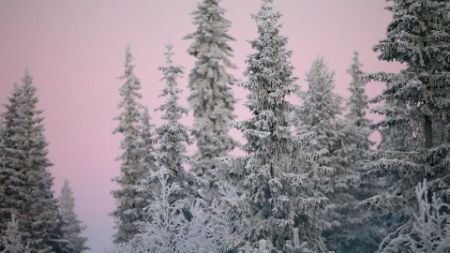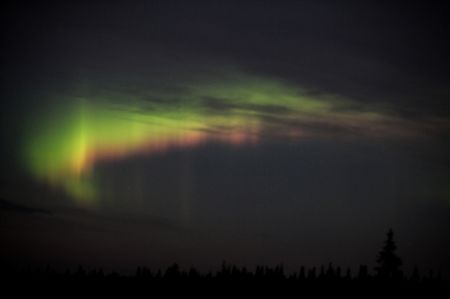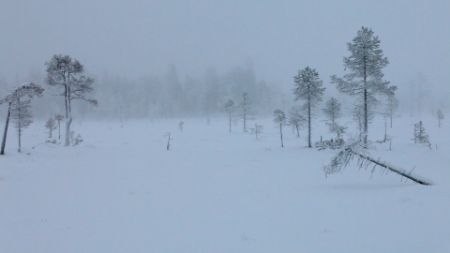
When one thinks of documentaries, some conventions come to mind: projections of facts and figures, narration, interviews. Yet none of these features are incorporated into Jessica Oreck’s AATSINKI: THE STORY OF ARCTIC COWBOYS, an often drifting, otherworldly look at a family’s reindeer herding operation in the arctic terrains of Finnish Lapland. Oreck’s decision to let go of the reigns and present her subject as if following a dream logic makes it quite unlike any documentary I’ve seen.
As the cameras take us on a meandering yet wondrous tour of this distant corner of the world, we are given insightful glimpses about a way of life that is excitingly close to achieving a harmony with nature.
While the title may evoke a sense of risk and bravado, AATSINKI speaks to a different connotation of the word ‘cowboys’: those living their life in a less comfortable frontier between civilization and the wild, and striving always to strike a balance between the two.
Colors are often brilliant and give way to breathtaking views of natural light shows in the sky and other wonders that Oreck allows the camera to rest on long enough so that the audience has a chance to take it in. Even a graphic cattle butchering scene takes on a vibrant wonder-filled quality, evoking a reaction altogether different than the expected disgust one might imagine.
I find it fascinating the way Oreck’s thoroughly hands off production allows themes and revelations about this unique way of life to form in the viewers’ subconscious. The importance of ritual, as we see repeated scenes of wood being carved into naturally curling arcs to be used for spoons and sometimes more elusive purposes. The stirring of a red powder into boiling water to make a routinely imbibed elixir is hypnotic. The passing of time is languid, fluid, defying any human construct of efficiency. We get a notion of this as we sit in on an unhurried CSI like investigation of a reindeer’s brush with a wolverine. The relaxed pace of the film may also serve the purpose of capturing the unforced passing of time.
A look at the Aatsinki family in their home celebrating Christmas may seem out of place, but the spell is not broken. The cameras still maintain a respectful observer’s distance and shots of the outside make us feel how truly isolated this outpost is from the inhabitable world. Even the interaction between the Aatsinki’s and their boisterous children seem modest, restrained, yet the bond between them is quite clear.
Silence speaks volumes about the reserved, quiet culture that this family is a part of. One gets the sense that the lack of chattiness is not any kind of standoffishness to the production, but a genuine part of their way of life. Perhaps it it comes of humility and respect for the great natural surroundings that leads them to use everything, even words, sparingly.
The hushed tones allow you to hear the lick of flames at a makeshift campsite. The hollow scuttling of antlers interlocking. Even the gentle stampeding of hundreds of reindeer holds a rhythmic, hypnotic quality. Within their lockstep movements is surely another mystery of nature there to reveal itself in its own time. And the areal views of them is incredible.
At a certain point in Aatsinki’s progression, (I think it was around spring), it dawned on me how this documentary could have been shaped much differently. Detailed accounts of the Aatsinki family’s history, ecological information about the reindeer, and other such information bytes that one finds in more conventional documentaries may have served to keep a greater number of viewers more attentive to the film. And yet, at the same time, a decision like this would have made all of its incomparable magic disappear in a wisp of smoke.
AATSINKI: THE STORY OF ARCTIC COWBOYS plays at the Tribeca Film Festival, where it also has its world premiere.



"...that this Icelandic family is a part of."
ReplyDeleteIt was actually filmed in finnish lappland, and the people in this are finnish.
Thanks for pointing this out. erased and gone without a trace. don't know what i was thinking. probably typed the word as a placeholder in a very early draft, and between sleep deprivation and scrambling around, didn't catch it. Doing some quick reading, i could see how the lack of distinction could raise some ire, too!
DeleteGod I wish I could agree. I saw nearly 40 films at Tribeca and this one was one of the biggest disappointments. It was a colossal bore and emotionally distancing to the extreme. The same intent was successfully navigated in THE FAST RUNNER and THE PATHFINDER. I am not at all surprised that it never once during the festival ever cracked the top ten in the Heinecken audience award daily scroll. Still you have written a wonderful; review I must say.
ReplyDeleteFor me the best docs were BRIDEGROOM, KISS THE WATER, OXYANA, CUTIE AND THE BOXER and DANCING IN JAFFA. Unfortunately I couldn't fit in a screening of ELAINE STRITCH.
Thanks for the kind words! i can definitely see the film turning off many viewers. And i did have the fortunate position of watching it without expectation - i don't watch a lot of such films - and without having to make a tremendous effort to see it. i did find many of the visuals stunning, like incredibly so, and the lack of a clear thread had an effect of getting my brain working to piece ideas together when it might've been in autopilot.
DeleteThat said, i did find myself drifting at times. At one point, i was thinking of writing 'it's a truly great movie to fall in and out of sleep to.' would that have been taken as a sincere compliment?!
I found RAW FISH similarly distant at times but very interesting to make sense of.
WIll be sure to visit your site and check some of your views!